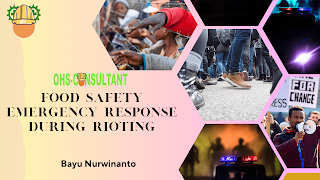In the event of a riot or emergency situation that threatens food safety, it is important to take immediate and appropriate action to protect people from potential hunger and food shortages. The following are the steps in developing a standard operating procedure (SOP) for food safety emergency response:
1. Situation Assessment:
- Evaluate the emergency situation, including the source and extent of the threat.
- Determine the affected areas and their level of vulnerability to food shortages.
- Form an emergency response team consisting of various stakeholders, such as the government, non-governmental organizations, and humanitarian aid organizations.
- Define the roles and responsibilities of each team member.
3. Food inventory and stockpiling:
- Identify available food supplies in the affected areas.
- Conduct an inventory of food supplies in warehouses and local food stores.
- Ensure smooth distribution and stock monitoring.
4. Food Distribution:
- Establish the location of emergency food distribution centers.
- Prioritize vulnerable groups, such as children, the elderly, and the sick.
- Ensure that food distribution takes place in a safe and orderly manner.
5. Food Quality and Safety Monitoring:
- Check the quality and safety of the food being distributed.
- Ensure that food is not contaminated or spoiled.
- Conduct rapid food safety tests if necessary.
6. Public Communication:
- Provide information to the public regarding the location and timing of emergency food distribution.
- Use social media, radio, and others to disseminate important information.
- Avoid spreading false information that could cause panic.
7. Collaboration with External Parties:
- Liaise with international organizations, donor agencies, and humanitarian agencies to secure additional assistance.
- Coordinate efforts with relevant agencies at the national and local levels.
8. Monitoring and Evaluation:
- Continuously monitor the situation and community needs.
- Evaluate the effectiveness of the emergency response and make improvements where necessary.
9. Recovery:
- Once the emergency situation has subsided, focus on the recovery and rehabilitation of the affected areas.
- Help communities restore their food security.
10. Documentation:
- Document all steps taken during a food safety emergency response for future learning.
These SOPs should always be updated and adapted to the situation that develops during an emergency. In addition, good coordination between all stakeholders and effective communication with the community are essential in implementing this SOP.


Post a Comment for "Ensuring Food Safety Amidst Chaos: Strategies for Emergency Response During Civil Unrest"